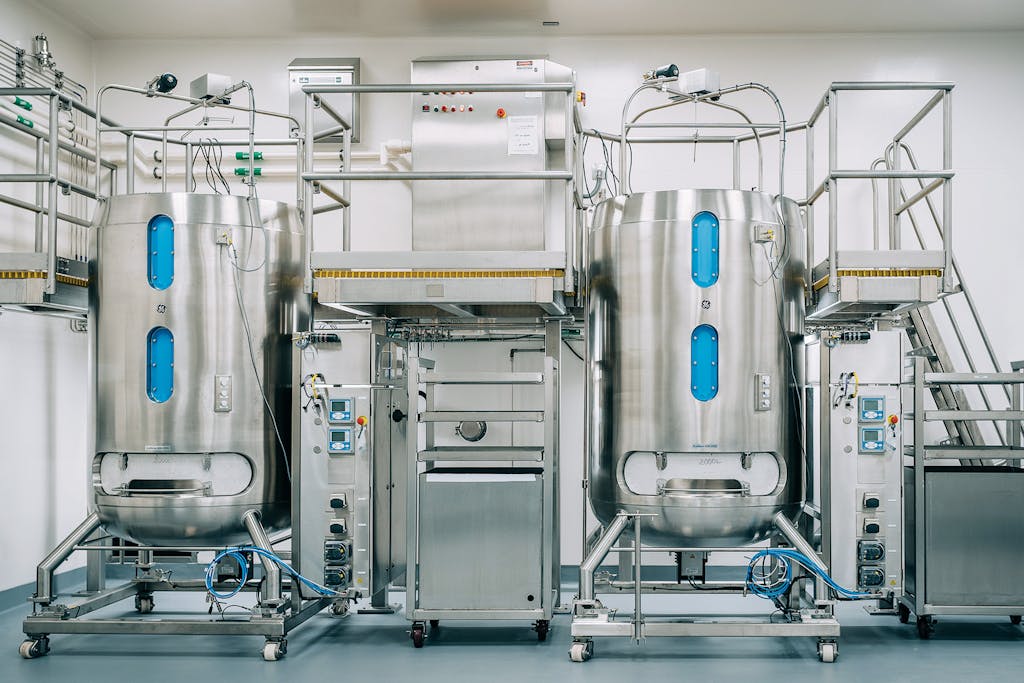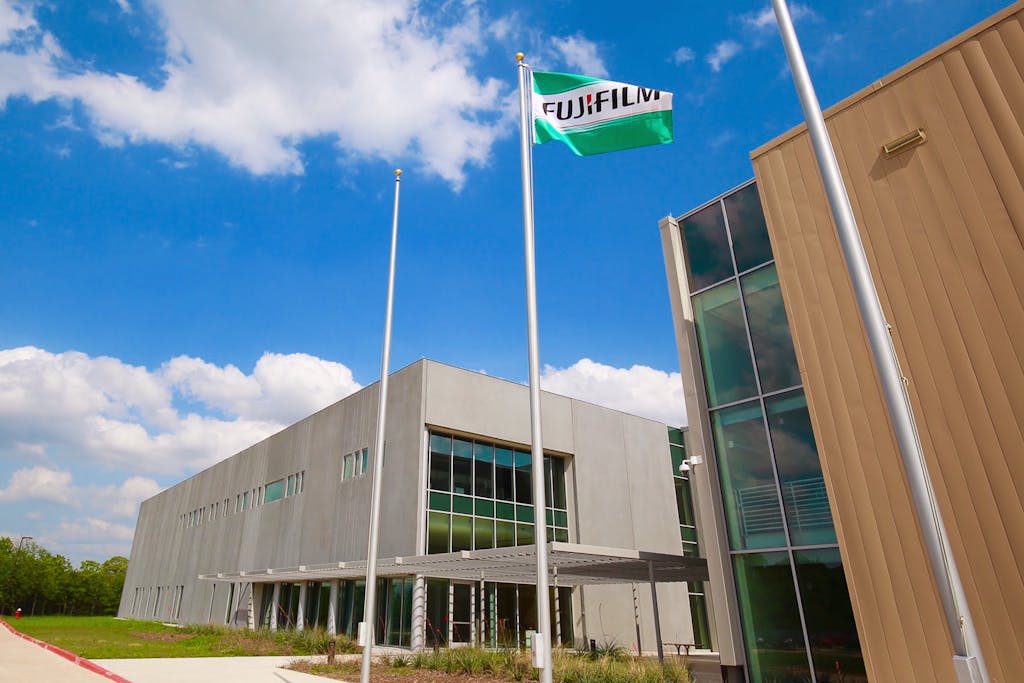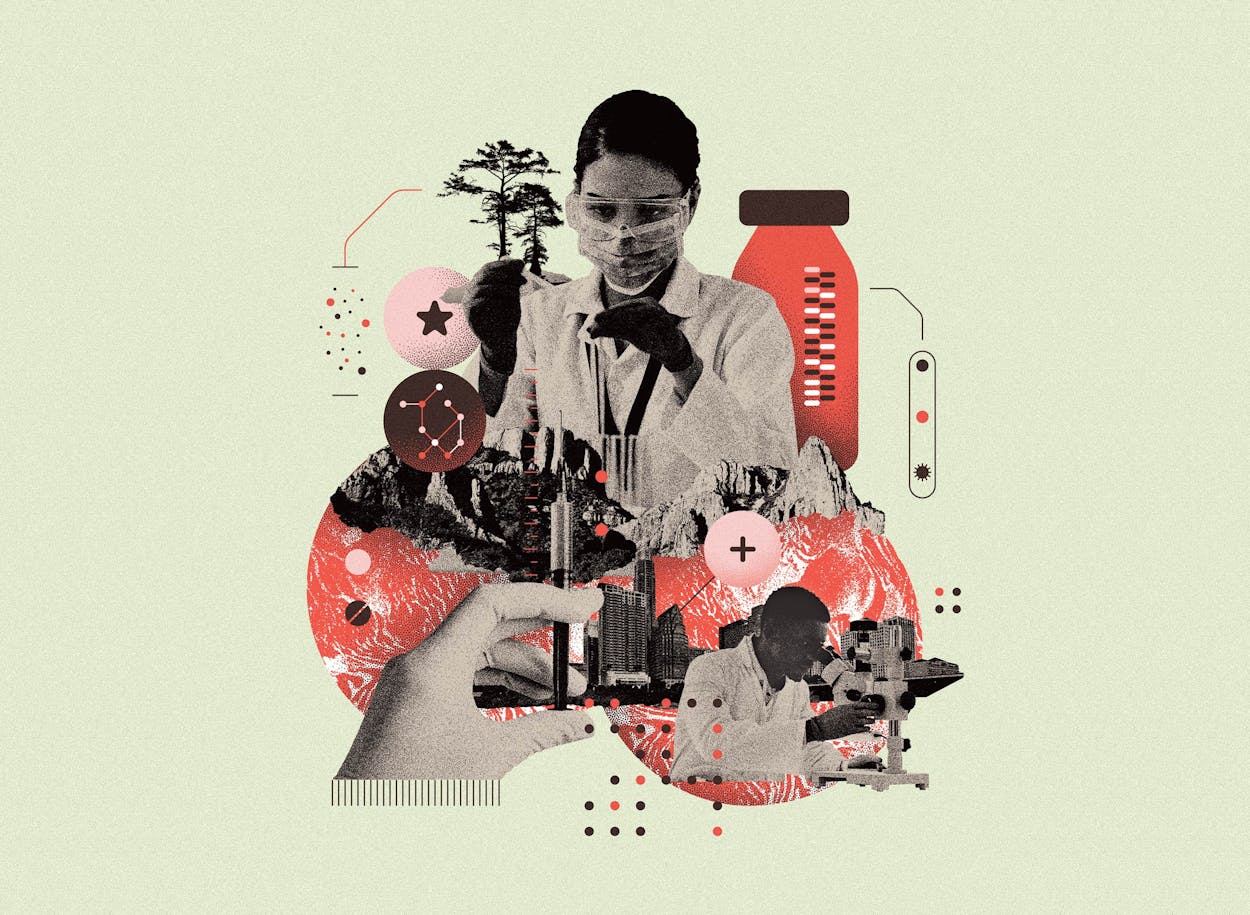When a winter storm and a mismanaged power grid hobbled much of Texas in mid-February, Thomas Page and his team couldn’t afford to shelter at home. For seven months they’d been working around the clock to make the key ingredient for two vaccines—their contribution to a worldwide effort to combat COVID-19. They weren’t about to let a deluge of snow slow them down.
So Page took to the icy streets of Bryan and College Station in his four-wheel-drive truck, picking up stranded staff members in need of a ride to the Fujifilm Diosynth Biotechnologies facility, just southwest of Texas A&M University. The company had prepared as best it could for the forecasted weather, even booking some of the plant’s six hundred employees into a hotel across the street, to ensure they could walk over if the roads became impassable.
Exempt from the statewide rolling blackouts, the Fujifilm building never lost power or water, even as tens of thousands of homes and businesses in the vicinity did. Yet, like most of Texas, it wasn’t designed to withstand days of single-digit temperatures. The water main started to freeze, significantly dropping the water pressure, and snowdrifts blocked air intakes for the boilers. “Our executives were taking turns shoveling snow,” says Page, a vice president of engineering and asset development for the company. “We were up for days just making sure everything was going to be okay.”
Through it all, the plant kept churning, fulfilling the mission the developers of Texas A&M’s Center for Innovation in Advanced Development and Manufacturing envisioned when it opened nearly a decade ago. Following vaccine shortages during the 2009 H1N1 (swine flu) pandemic, the federal Department of Health and Human Services invested $400 million to establish three CIADMs—one each in Maryland, North Carolina, and Texas—to expand the country’s medical manufacturing capacity. Fujifilm, a Japanese conglomerate with interests in biotechnology, electronics, and photography, has a contract with A&M’s CIADM (“cee-add-um” to insiders) that requires it to do the bidding of the federal government in the case of a national emergency. COVID-19 marked the first time it was drafted into service.
Nearly three quarters of all facilities that produce drugs for the U.S. market are located outside the country, according to the Food and Drug Administration. That leaves Americans vulnerable to losing access to vital medicines during a disruptive global event, such as a pandemic. COVID-19 has further exposed just how many lifesaving drugs are made overseas, sparking a renewed push to repatriate this manufacturing and underlining the importance of the arrival of the CIADM in College Station in 2012. “There were people who recognized then—and who still recognize and push today—that having aircraft carriers and nuclear missiles is really important, but having drugs to take care of Americans when they are sick is equally strategically important,” says William Jay Treat, the chief manufacturing officer of the Texas A&M CIADM.

For decades, the state has been a hub for groundbreaking medical research, but the manufacturing of products drawn from that research took place mostly at established biotechnology centers on the East and West Coasts. Texas lacked the necessary facilities and the specially trained workforce. But that’s been changing in recent years, with the biotech industry growing at a faster rate in the state than across the nation as a whole. The CIADM was one of the “foundational investments” of that transformation, says Jennifer Maynard, a professor of chemical engineering at the University of Texas at Austin whose research focuses on developing therapeutics and vaccines for infectious diseases.
The A&M CIADM has demonstrated that the investment was worthwhile, Treat argues. “It shows that Texas can be a base for manufacturing, that we can recruit talent and develop our own workforce,” he says. “And investors have seen the value of locating in Texas.”
Indeed, Page jumped at the chance to return to his native Texas eight years ago, when he was recruited by A&M to set up the initial CIADM facilities. (He was later hired by Fujifilm.) After having earned his undergraduate degree in College Station and his doctorate from Rice University, Page had to leave the state to find career opportunities in biotechnology. Boston is where he honed his winter driving skills. “I was living the coastal life from the Northeast to California—the biotech hotbeds,” he says. Now “people are talking about Texas as the third coast.”
Fifty years ago, most medications sold in the United States were made here too. But drug manufacturing gradually shifted overseas to countries such as China and India that offered cheap land and labor, along with lax regulations. “Increases in the cost of developing a new drug—presently averaging around $2.7 billion—pressured companies to look for ways to save money,” says Dr. Paul Beninger, an associate professor of public health and community medicine at Tufts University.
However, some advanced domestic manufacturing is becoming cost-effective again, thanks to the advent of smaller, highly automated plants and a new generation of treatments—particularly cell and gene therapies—requiring specialized technologies in which the U.S. dominates. With top-tier medical research universities, high-tech talent in the labor pool, and plenty of wide-open space for new plants, Texas seems in prime position to capitalize on these trends. The state isn’t yet competing with the likes of California, which employs nearly four times as many in the sector, but from 2010 to 2018, the number of companies researching, developing, and manufacturing drugs in Texas increased from 154 to 232, adding nearly three thousand workers, according to the industry trade group Biotechnology Innovation Organization. From 2016 to 2018, the number of companies in Texas manufacturing pharmaceuticals increased by 28 percent, compared with just 18 percent nationwide.
One drugmaker that has expanded its presence in Texas in recent years is Lonza, which in 2018 opened the world’s largest cell- and gene-therapy facility in the Houston suburb of Pearland. The Swiss company expects to have about six hundred employees there by the end of 2021 and hopes to hire more than a hundred more annually over the next few years. Several factors sold Lonza on the area, including its demographic diversity, the groundbreaking research at its universities, and its access to manufacturing expertise, says Frank Bugg, a native Texan who moved back from New England to head up the Lonza plant. “That breadth of knowledge is something that is very attractive,” he says.
Also driving the repatriation of drug manufacturing are concerns about national security and protection of intellectual property. “Having better physical control of manufacturing sites significantly reduces risk,” Beninger says. “There is just an increasing level of concern about being held hostage” by foreign governments. Although the COVID-19 pandemic has added to these anxieties, they aren’t new.
The federal government can stockpile some vital medical products, but others—such as newly developed vaccines for novel diseases—can be produced only in response to a specific threat. State-of-the-art manufacturing facilities and expertise must be available on standby, which is just what the CIADMs were set up to establish.

Biological Bonanza
The cell- and gene-therapy market is projected to grow 30 percent annually and reach $14 billion globally by 2025.
Of the initial $400 million that the feds invested in CIADMs, $175 million went to Texas A&M’s program, along with another $40 million from the state government. The university kicked in $20 million. A&M was chosen to run a CIADM largely because of its National Center for Therapeutics Manufacturing, an education and research institution funded by a hefty state grant in 2009, which today also trains workers for the Fujifilm plant. The initial CIADM investment built the facility that Fujifilm now uses, though the company has since purchased the buildings and the land from the school.
The CIADMs are intended to foster just this sort of public-private partnership. The federal government benefits from a major biomanufacturing company being on call in case of emergencies. The university recouped its initial investment by selling land and high-tech facilities to Fujifilm. The state can boast of having attracted a new company offering high-paying jobs. And Fujifilm got a large-scale plant at a bargain price because it accepted the government obligation that came with it. The company also stands to earn the bulk of the $265 million vaccine-manufacturing contract between the government and the CIADM.
Texas A&M’s CIADM is the only one run by an academic institution rather than by a drug company. Under the auspices of the CIADM, the university is establishing an ecosystem of biotech companies to help it commercialize research and provide a job pipeline for students. Its other commercial partners include iBio, which focuses on plant-based therapies for infectious diseases; Matica Biotechnology, which develops virus-based therapies and vaccines; and Zoetis, which makes veterinary drugs and vaccines. The CIADM helps these companies by, for instance, providing staff and lab space and shepherding them through the maze of drug approval.
The other CIADM working on COVID-19 vaccines is in Maryland, managed by drugmaker Emergent Biosolutions. It made headlines at the end of March for spoiling up to 15 million potential doses when it mixed up ingredients for the Johnson & Johnson and AstraZeneca vaccines. That wasn’t the first time the CIADMs drew unfortunate attention. Two reviews—one conducted in late 2017 by HHS and the Department of Defense, and another in 2019 by the government-funded research organization MITRE—found that the CIADMs might not be ready to meet the nation’s biodefense goals because of a dearth of ongoing government funding. An HHS spokesperson told me that although the facilities ramped up relatively quickly to produce COVID-19 vaccines, that process would have moved even faster if the government had invested more prior to the pandemic.
Beninger likewise noted that the private sector alone isn’t set up to respond to the sort of emergency COVID-19 has presented. “One of the things that has made commercial manufacturing so successful is that it’s lean and mean,” he says. “They don’t have a lot of excess capacity.” Most of these facilities lack the ability to change course quickly. “We’ve been so focused on efficiencies that we’ve really forgotten about what might happen when things don’t work, when the usual supply chains break down.”
Before COVID-19, Fujifilm’s College Station plant was working on cell therapies used to treat cancer and autoimmune diseases, as well as other vaccines. “By bringing in these other products, they got manufacturing, quality assurance, and regulatory people in place. They lined up various vendors and put the infrastructure in,” Treat says. “That allowed them to move so quickly into doing this vaccine for COVID-19.”

The federal government’s Operation Warp Speed went into business with the pharmaceutical industry in the spring of 2020 to ramp up manufacturing on eight promising vaccine candidates even as clinical trials were underway. As of early April 2021, the FDA had authorized only three of them: those from Johnson & Johnson, Moderna, and Pfizer-BioNTech.
The A&M CIADM—which in turn hired Fujifilm—was tapped last July to make two of the other vaccines, one developed by Novavax and the other a collaboration between Sanofi and GlaxoSmithKline. Six months and 100,000 person-hours later—after complex preparations that typically take two to three times that long—the Fujifilm plant was producing the ingredients for millions of vaccine doses every week.
After disappointing early results in clinical trials, Sanofi and GSK had to retool their formula, so the CIADM’s early production runs of the vaccine had to be discarded. A spokesperson for Sanofi says the company still hopes the drug will be available by the fall. Meanwhile, the Novavax vaccine, which the company reports was roughly 90 percent effective in a Phase 3 trial in the UK, appears on track to receive FDA authorization later this spring. Novavax has promised the U.S. government it’ll have 110 million doses ready by July. (Like the Moderna and Pfizer vaccines, Novavax’s requires two doses.)
Fujifilm occupies about forty acres of former cow pasture in College Station. The building where the COVID-19 vaccine components are made is a long rectangle that sits on roughly two of those acres. A larger building next door contains a warehouse, offices, and testing labs. Because of pandemic restrictions on visitors, Page could only give me a virtual tour in early March. Down one long, white corridor lined with gray doors and occasional windows offering views into work rooms, he pointed out the building’s hidden complexities, including electronic controls and mechanical airlocks to facilitate the use of living material in manufacturing. “Typically with biotechnology, you are using cells as factories,” Page says. “You have to keep the outside out and the inside in.” That requires keeping the air pressure lower in some rooms and higher in others.
Both the Novavax and Sanofi-GSK vaccines teach the immune system to recognize the spike protein that protrudes from the surface of SARS-CoV-2, the coronavirus that causes COVID-19. The process of doing that begins in the plant’s inoculum room, the smallest of the work rooms. At two stations, workers clad head to toe in white protective suits reach into gloved portals in isolation chambers to transfer vials of cultivated moth cells into flasks. The flasks are then placed inside an incubator to trigger cell replication. As the cells continue to multiply, the solution in which they are suspended is transferred, through tubing in the walls, to a series of large stainless-steel tanks called bioreactors in other work rooms. Finally, they reach one of four 500-gallon containers in the “ballroom,” which looks something like a modern brewery.
There, workers introduce a modified version of a virus specific to insects (thus the use of moth cells), called a baculovirus, which instructs the cells to make the spike proteins. The final steps involve removing the virus and any other impurities. “What you end up with is a pure, highly concentrated solution of spike protein,” Page says. “That’s the active ingredient.”
The process is highly automated, so the small team managing it spends time mostly sitting at the computer or monitoring controls. Page rattles off a long list of others working behind the scenes of the process we’re observing: engineers, facilities staff, those who procure the raw materials, those producing the highly purified water and gases needed, quality assurance workers, and many more. He shakes his head. “I think people don’t understand what a complex undertaking this is, to do this in this timeline,” he says.
Two identical production lines, one for each vaccine, run 24 hours a day on either side of the central corridor. Fujifilm is the only U.S. plant making the spike protein for Novavax; Sanofi also makes some of the protein at its plants in France, where it’s headquartered. The other ingredient for the vaccines, an “adjuvant” that heightens the immune response in humans who receive the vaccine, requires different, simpler production techniques and is made at other facilities.
After a career that took him to both coasts and helped launch the A&M CIADM, Page is exactly where he wants to be, doing what he’s always wanted to do. He is most animated when talking about the potential of cell and gene therapies to prevent serious infections, cure cancer, and treat genetic disease. “There is a lot of suffering out there that this industry has a potential to solve, soon,” he says.
There’s a huge opportunity for Texas to take the lead in manufacturing the next generation of drugs, says UT professor Maynard. Boasting a state-of-the-art facility pumping out vaccines for a pandemic feels, to her, like a milestone. “Looking back, we will probably say this was the inflection point,” she says.
Teresa Carr is an Austin-based science writer whose work has appeared in Undark Magazine, the New York Times, the Guardian, and Consumer Reports.
This article originally appeared in the May 2021 issue of Texas Monthly with the headline “Biotech’s Third Coast.” Subscribe today.
- More About:
- Health
- Business
- Medicine
- College Station







